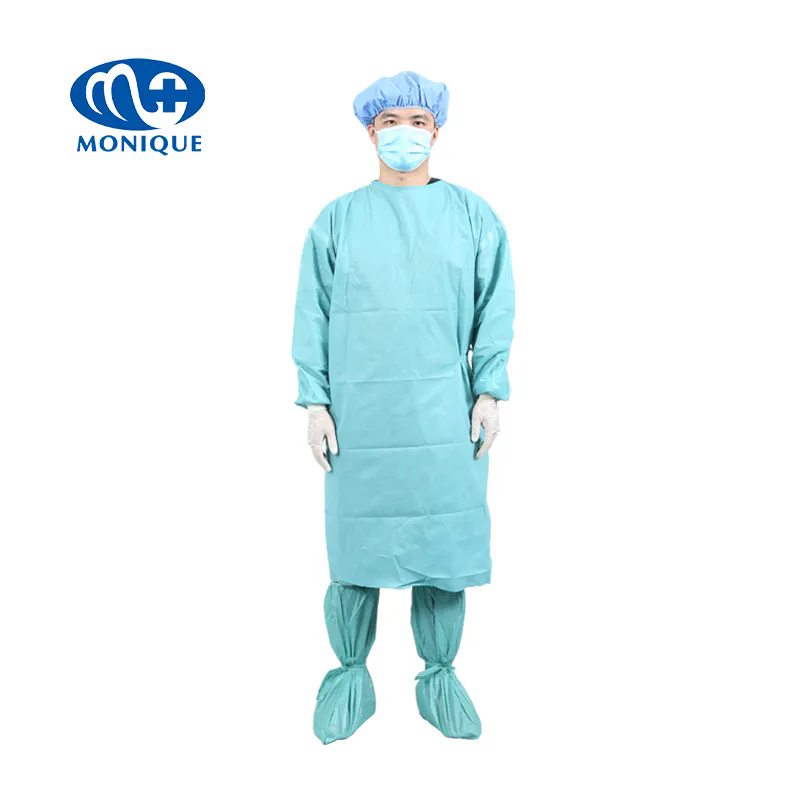Why Are Disposable Surgical Gowns Essential for Healthcare Settings?
2024-12-06
In healthcare environments, safety and hygiene are paramount. Whether it’s a hospital, clinic, or surgery center, healthcare professionals work in conditions where contamination risks are high. To combat these risks, disposable surgical gowns are an indispensable part of medical attire. But why are disposable surgical gowns so crucial for maintaining health and safety standards in these settings? Let's explore the reasons why these garments are an essential tool in modern healthcare.
1. What Are Disposable Surgical Gowns?
A disposable surgical gown is a single-use garment worn by healthcare professionals, primarily during surgeries or when dealing with patients in sterile environments. These gowns are designed to provide a barrier against fluids, bacteria, and other potential contaminants, protecting both the patient and the medical staff from cross-contamination.
Made from materials like nonwoven fabric, these gowns are lightweight, breathable, and designed for one-time use. They come in various sizes and levels of protection, depending on the specific requirements of the procedure or the healthcare setting.
2. How Do Disposable Surgical Gowns Protect Healthcare Workers?
Healthcare professionals are constantly exposed to potentially harmful fluids, bacteria, and viruses while treating patients. Disposable surgical gowns serve as a critical barrier between the healthcare worker and any harmful substances that may be present in the environment. Here’s how they contribute to safety:
- Protection from Contaminants: Surgical gowns are designed to prevent fluids, such as blood, body fluids, or other substances, from splashing onto the skin and clothing of medical staff. This reduces the risk of infections that could spread through contact.
- Prevention of Cross-Contamination: In a sterile environment, such as an operating room, it is essential to maintain a barrier to protect both the patient and medical professionals from contamination. Disposable gowns prevent healthcare workers from transferring bacteria or viruses from one patient to another, or from other surfaces, reducing the risk of cross-contamination.
- Reducing the Spread of Infection: Healthcare professionals who wear disposable gowns prevent contaminants from adhering to their clothing, thus helping to reduce the spread of infections in hospital settings. This is especially crucial in environments with vulnerable patients, such as those undergoing surgery, chemotherapy, or those in intensive care units.
3. How Do Disposable Surgical Gowns Contribute to Infection Control?
Infection control is a critical aspect of modern healthcare. Hospitals are often breeding grounds for various infections due to the concentration of sick patients, exposure to bodily fluids, and the constant movement of staff. Surgical gowns play a vital role in infection control efforts by:
- Maintaining a Sterile Field: Surgical procedures require a sterile environment to prevent infection during operations. Gowns are part of the personal protective equipment (PPE) that ensures healthcare workers do not introduce contaminants into the surgical area.
- Enhancing Personal Safety: For medical workers, wearing a disposable surgical gown adds an extra layer of protection against exposure to infectious agents, such as bacteria, viruses, or fungi that may be present during surgical procedures or patient care.
- Compliance with Health Regulations: Healthcare facilities are required to adhere to strict infection control standards. Disposable surgical gowns help meet these regulatory requirements, ensuring that staff and patients are protected during high-risk medical procedures.
4. Why Are Disposable Surgical Gowns Preferred Over Reusable Gowns?
While reusable gowns have been an option in the past, disposable surgical gowns are now the preferred choice in most healthcare settings. Here’s why disposable gowns have gained popularity:
- Hygiene and Safety: Disposable gowns are used once and then discarded, eliminating the risk of contamination that may occur with reusable gowns that are laundered and reused. This ensures a higher level of hygiene and reduces the chances of infection.
- Convenience: Disposable gowns are ready to use, require no laundering, and can be easily disposed of after use. This makes them more convenient for healthcare workers who need to quickly change into protective clothing during busy shifts.
- Cost-Effectiveness: Although disposable gowns may seem more expensive initially, they are cost-effective in the long run. Healthcare facilities save money on laundry services, time spent cleaning, and the risk of reusing contaminated gowns.
- Compliance with Safety Standards: Disposable surgical gowns are manufactured to meet specific safety standards and regulations, ensuring they offer the required protection for both the patient and healthcare worker.
5. What Are the Different Types of Disposable Surgical Gowns?
Not all disposable surgical gowns are created equal. They come in various types, designed to meet specific needs and levels of protection. Some of the key factors to consider when selecting the right gown include:
- Material Composition: Surgical gowns can be made from a range of materials, such as SMS (Spunbond-Meltblown-Spunbond), polypropylene, or polyethylene. Each material offers a different level of protection against fluid penetration and microbial contamination.
- Protection Level: Disposable surgical gowns are categorized by the level of protection they provide, such as basic, moderate, or high protection. For example, a level 4 gown would be used for procedures involving high-risk exposure to bodily fluids, while a level 1 gown might be appropriate for non-invasive procedures.
- Design Features: Some disposable gowns come with additional features such as reinforced areas for extra protection, adjustable necklines, and elastic cuffs to prevent fluid from seeping into the garment. Others may have more breathable materials to enhance comfort during long procedures.
6. How Do Disposable Surgical Gowns Contribute to Public Health?
The importance of disposable surgical gowns extends beyond the individual hospital or clinic. By reducing the risk of infection and contamination, these gowns play a role in improving public health overall. They:
- Help Control the Spread of Infectious Diseases: In settings where contagious diseases are a concern, disposable surgical gowns can help prevent the spread of infections like MRSA, tuberculosis, and even COVID-19. They limit the exposure of harmful microorganisms to both healthcare workers and patients.
- Support Global Healthcare Efforts: In regions with limited healthcare resources or during outbreaks of infectious diseases, disposable gowns provide an affordable and effective means of protecting medical personnel and patients. They are often part of emergency response protocols in hospitals and clinics around the world.
7. Conclusion: The Vital Role of Disposable Surgical Gowns
In conclusion, disposable surgical gowns are a vital part of the healthcare system, ensuring that healthcare workers are protected and that patients are kept safe from infection. These garments are not just a simple piece of clothing; they are a crucial component of the infection control and safety protocols that keep hospitals and healthcare facilities running smoothly. By providing a barrier against contaminants and ensuring that medical staff remain sterile, disposable surgical gowns help maintain the integrity of healthcare settings and ultimately save lives.



